Remuneration and Performance Management: Article Comparison
VerifiedAdded on 2022/12/26
|8
|1861
|64
Report
AI Summary
This report provides a comparative analysis of two journal articles focused on performance management and remuneration strategies. The first article, "Performance management effectiveness: lessons from world-leading firms," discusses the importance of performance management in organizations, the use of signaling theory, and the significance of structural practices such as senior management involvement, feedback mechanisms, clear communication, and rater training. The second article, "Performance management effectiveness: practices or context?" emphasizes the mutual influence of practices and context, highlighting the positive association of employee recognition, training, and development with performance management, as well as the relevance of contextual variables like climate, strategic integration, and human resource management culture. The report identifies similarities, such as the importance of effective performance management practices and employee recognition, and dissimilarities, particularly the emphasis on organizational context. The conclusion underscores the importance of effective performance management for organizational success and employee motivation, despite differing approaches.
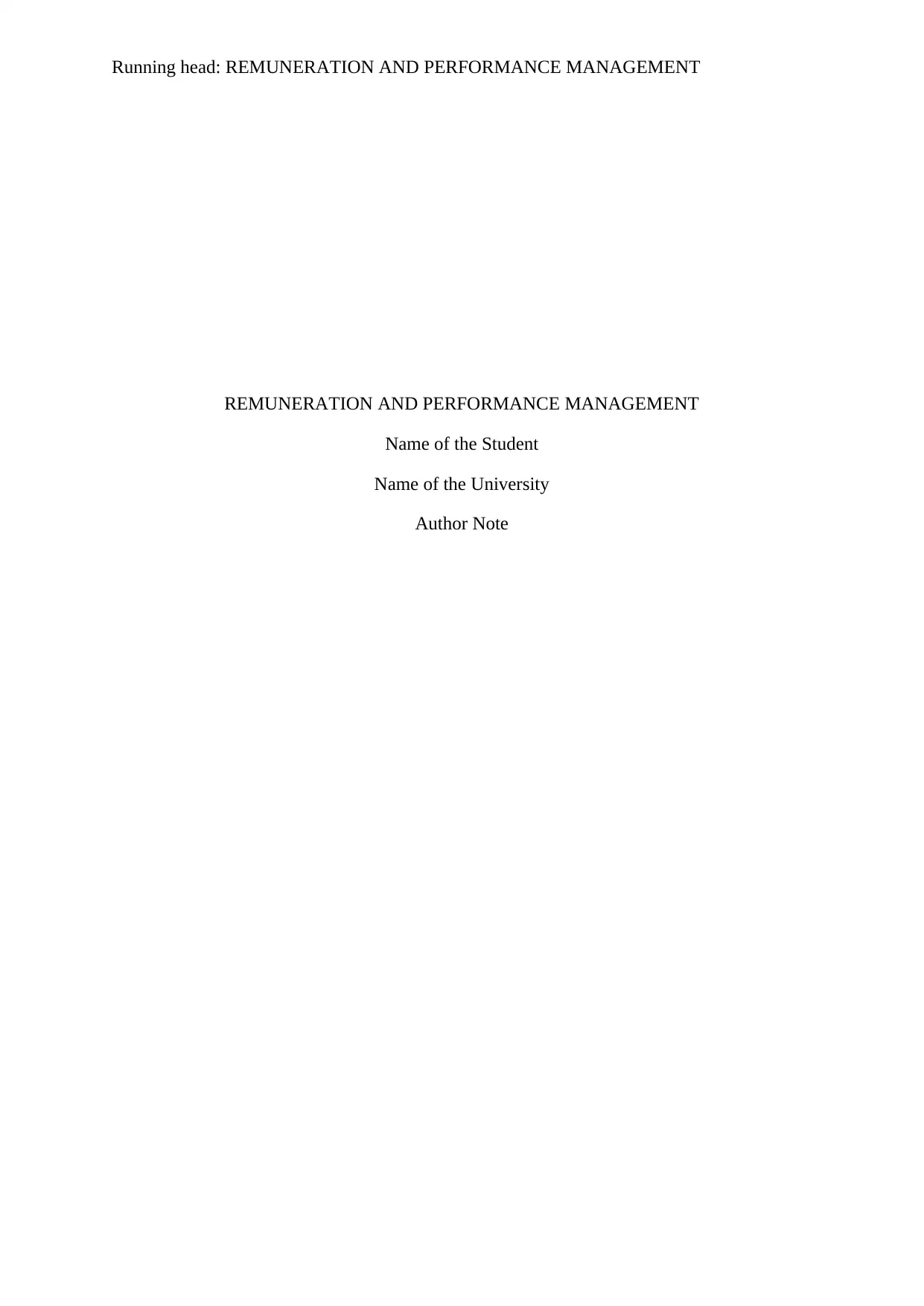
Running head: REMUNERATION AND PERFORMANCE MANAGEMENT
REMUNERATION AND PERFORMANCE MANAGEMENT
Name of the Student
Name of the University
Author Note
REMUNERATION AND PERFORMANCE MANAGEMENT
Name of the Student
Name of the University
Author Note
Paraphrase This Document
Need a fresh take? Get an instant paraphrase of this document with our AI Paraphraser
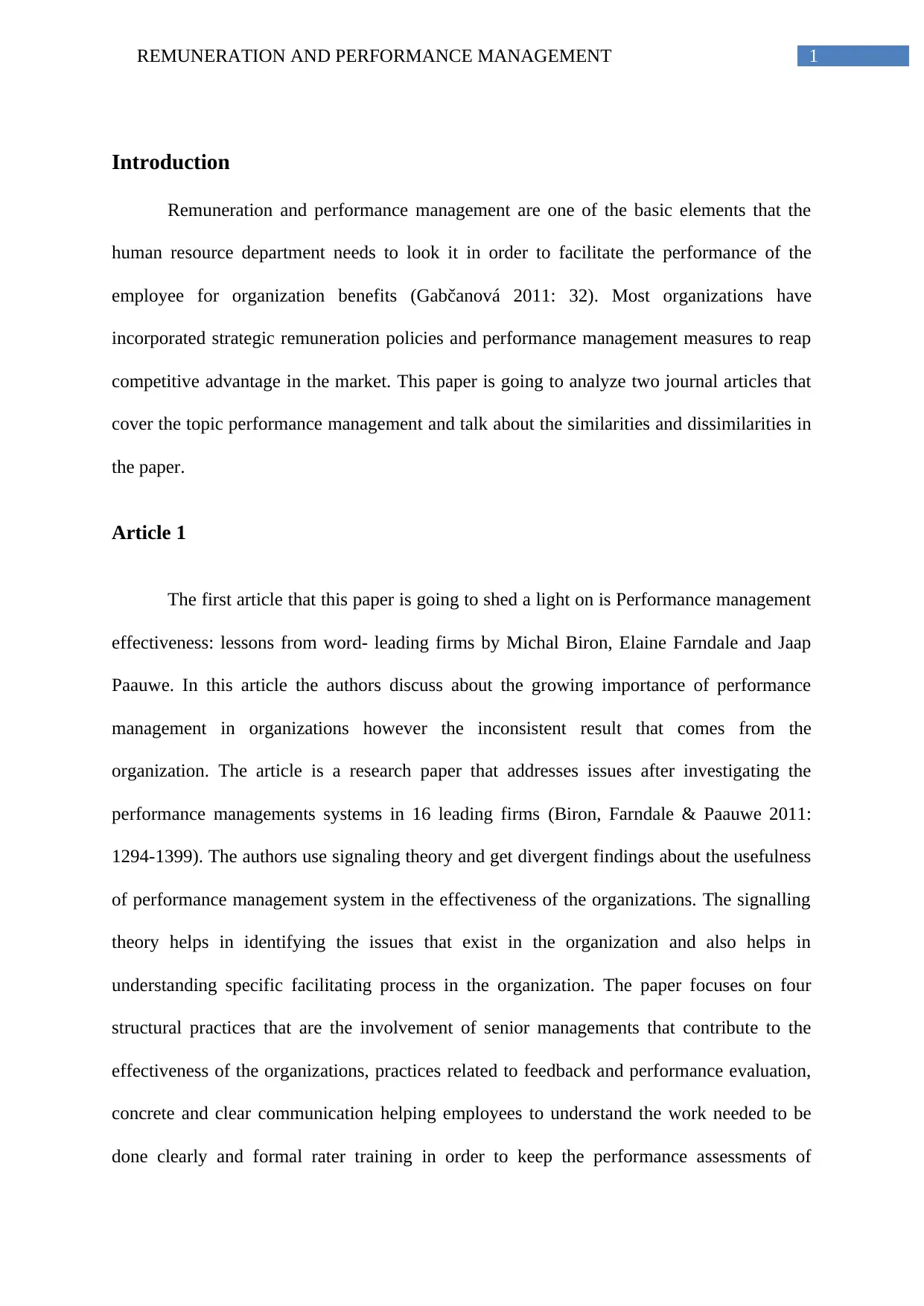
1REMUNERATION AND PERFORMANCE MANAGEMENT
Introduction
Remuneration and performance management are one of the basic elements that the
human resource department needs to look it in order to facilitate the performance of the
employee for organization benefits (Gabčanová 2011: 32). Most organizations have
incorporated strategic remuneration policies and performance management measures to reap
competitive advantage in the market. This paper is going to analyze two journal articles that
cover the topic performance management and talk about the similarities and dissimilarities in
the paper.
Article 1
The first article that this paper is going to shed a light on is Performance management
effectiveness: lessons from word- leading firms by Michal Biron, Elaine Farndale and Jaap
Paauwe. In this article the authors discuss about the growing importance of performance
management in organizations however the inconsistent result that comes from the
organization. The article is a research paper that addresses issues after investigating the
performance managements systems in 16 leading firms (Biron, Farndale & Paauwe 2011:
1294-1399). The authors use signaling theory and get divergent findings about the usefulness
of performance management system in the effectiveness of the organizations. The signalling
theory helps in identifying the issues that exist in the organization and also helps in
understanding specific facilitating process in the organization. The paper focuses on four
structural practices that are the involvement of senior managements that contribute to the
effectiveness of the organizations, practices related to feedback and performance evaluation,
concrete and clear communication helping employees to understand the work needed to be
done clearly and formal rater training in order to keep the performance assessments of
Introduction
Remuneration and performance management are one of the basic elements that the
human resource department needs to look it in order to facilitate the performance of the
employee for organization benefits (Gabčanová 2011: 32). Most organizations have
incorporated strategic remuneration policies and performance management measures to reap
competitive advantage in the market. This paper is going to analyze two journal articles that
cover the topic performance management and talk about the similarities and dissimilarities in
the paper.
Article 1
The first article that this paper is going to shed a light on is Performance management
effectiveness: lessons from word- leading firms by Michal Biron, Elaine Farndale and Jaap
Paauwe. In this article the authors discuss about the growing importance of performance
management in organizations however the inconsistent result that comes from the
organization. The article is a research paper that addresses issues after investigating the
performance managements systems in 16 leading firms (Biron, Farndale & Paauwe 2011:
1294-1399). The authors use signaling theory and get divergent findings about the usefulness
of performance management system in the effectiveness of the organizations. The signalling
theory helps in identifying the issues that exist in the organization and also helps in
understanding specific facilitating process in the organization. The paper focuses on four
structural practices that are the involvement of senior managements that contribute to the
effectiveness of the organizations, practices related to feedback and performance evaluation,
concrete and clear communication helping employees to understand the work needed to be
done clearly and formal rater training in order to keep the performance assessments of
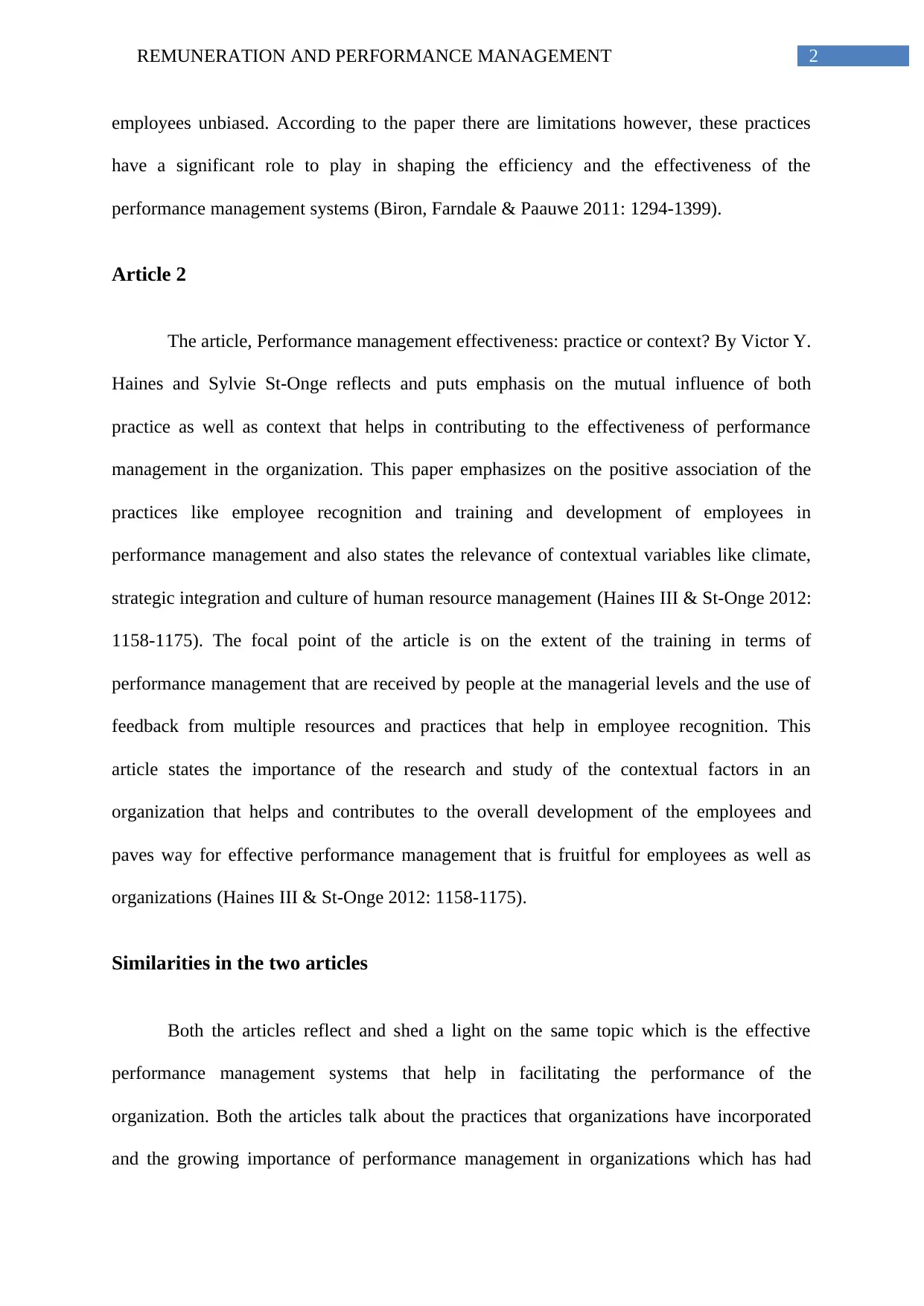
2REMUNERATION AND PERFORMANCE MANAGEMENT
employees unbiased. According to the paper there are limitations however, these practices
have a significant role to play in shaping the efficiency and the effectiveness of the
performance management systems (Biron, Farndale & Paauwe 2011: 1294-1399).
Article 2
The article, Performance management effectiveness: practice or context? By Victor Y.
Haines and Sylvie St-Onge reflects and puts emphasis on the mutual influence of both
practice as well as context that helps in contributing to the effectiveness of performance
management in the organization. This paper emphasizes on the positive association of the
practices like employee recognition and training and development of employees in
performance management and also states the relevance of contextual variables like climate,
strategic integration and culture of human resource management (Haines III & St-Onge 2012:
1158-1175). The focal point of the article is on the extent of the training in terms of
performance management that are received by people at the managerial levels and the use of
feedback from multiple resources and practices that help in employee recognition. This
article states the importance of the research and study of the contextual factors in an
organization that helps and contributes to the overall development of the employees and
paves way for effective performance management that is fruitful for employees as well as
organizations (Haines III & St-Onge 2012: 1158-1175).
Similarities in the two articles
Both the articles reflect and shed a light on the same topic which is the effective
performance management systems that help in facilitating the performance of the
organization. Both the articles talk about the practices that organizations have incorporated
and the growing importance of performance management in organizations which has had
employees unbiased. According to the paper there are limitations however, these practices
have a significant role to play in shaping the efficiency and the effectiveness of the
performance management systems (Biron, Farndale & Paauwe 2011: 1294-1399).
Article 2
The article, Performance management effectiveness: practice or context? By Victor Y.
Haines and Sylvie St-Onge reflects and puts emphasis on the mutual influence of both
practice as well as context that helps in contributing to the effectiveness of performance
management in the organization. This paper emphasizes on the positive association of the
practices like employee recognition and training and development of employees in
performance management and also states the relevance of contextual variables like climate,
strategic integration and culture of human resource management (Haines III & St-Onge 2012:
1158-1175). The focal point of the article is on the extent of the training in terms of
performance management that are received by people at the managerial levels and the use of
feedback from multiple resources and practices that help in employee recognition. This
article states the importance of the research and study of the contextual factors in an
organization that helps and contributes to the overall development of the employees and
paves way for effective performance management that is fruitful for employees as well as
organizations (Haines III & St-Onge 2012: 1158-1175).
Similarities in the two articles
Both the articles reflect and shed a light on the same topic which is the effective
performance management systems that help in facilitating the performance of the
organization. Both the articles talk about the practices that organizations have incorporated
and the growing importance of performance management in organizations which has had
⊘ This is a preview!⊘
Do you want full access?
Subscribe today to unlock all pages.

Trusted by 1+ million students worldwide
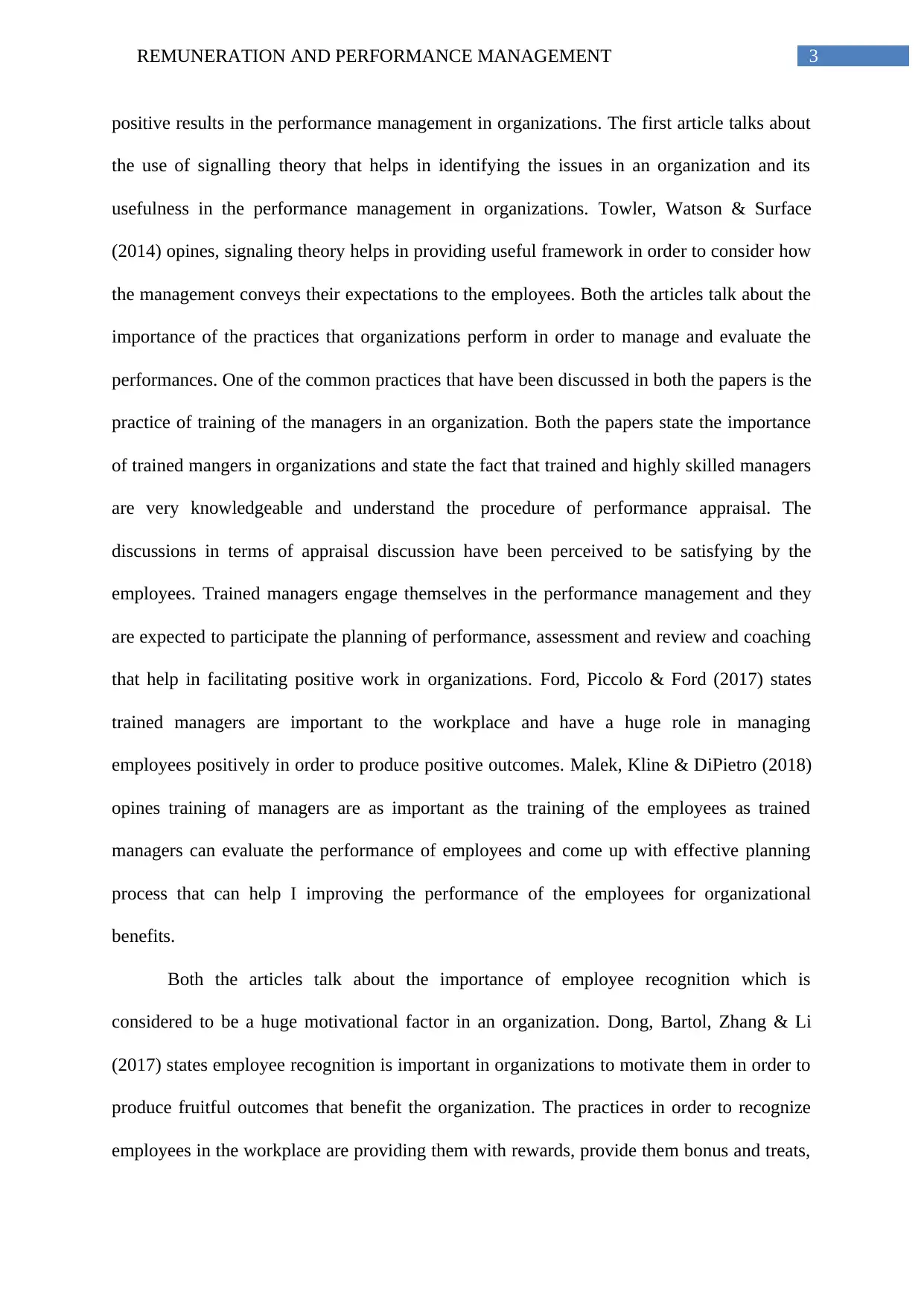
3REMUNERATION AND PERFORMANCE MANAGEMENT
positive results in the performance management in organizations. The first article talks about
the use of signalling theory that helps in identifying the issues in an organization and its
usefulness in the performance management in organizations. Towler, Watson & Surface
(2014) opines, signaling theory helps in providing useful framework in order to consider how
the management conveys their expectations to the employees. Both the articles talk about the
importance of the practices that organizations perform in order to manage and evaluate the
performances. One of the common practices that have been discussed in both the papers is the
practice of training of the managers in an organization. Both the papers state the importance
of trained mangers in organizations and state the fact that trained and highly skilled managers
are very knowledgeable and understand the procedure of performance appraisal. The
discussions in terms of appraisal discussion have been perceived to be satisfying by the
employees. Trained managers engage themselves in the performance management and they
are expected to participate the planning of performance, assessment and review and coaching
that help in facilitating positive work in organizations. Ford, Piccolo & Ford (2017) states
trained managers are important to the workplace and have a huge role in managing
employees positively in order to produce positive outcomes. Malek, Kline & DiPietro (2018)
opines training of managers are as important as the training of the employees as trained
managers can evaluate the performance of employees and come up with effective planning
process that can help I improving the performance of the employees for organizational
benefits.
Both the articles talk about the importance of employee recognition which is
considered to be a huge motivational factor in an organization. Dong, Bartol, Zhang & Li
(2017) states employee recognition is important in organizations to motivate them in order to
produce fruitful outcomes that benefit the organization. The practices in order to recognize
employees in the workplace are providing them with rewards, provide them bonus and treats,
positive results in the performance management in organizations. The first article talks about
the use of signalling theory that helps in identifying the issues in an organization and its
usefulness in the performance management in organizations. Towler, Watson & Surface
(2014) opines, signaling theory helps in providing useful framework in order to consider how
the management conveys their expectations to the employees. Both the articles talk about the
importance of the practices that organizations perform in order to manage and evaluate the
performances. One of the common practices that have been discussed in both the papers is the
practice of training of the managers in an organization. Both the papers state the importance
of trained mangers in organizations and state the fact that trained and highly skilled managers
are very knowledgeable and understand the procedure of performance appraisal. The
discussions in terms of appraisal discussion have been perceived to be satisfying by the
employees. Trained managers engage themselves in the performance management and they
are expected to participate the planning of performance, assessment and review and coaching
that help in facilitating positive work in organizations. Ford, Piccolo & Ford (2017) states
trained managers are important to the workplace and have a huge role in managing
employees positively in order to produce positive outcomes. Malek, Kline & DiPietro (2018)
opines training of managers are as important as the training of the employees as trained
managers can evaluate the performance of employees and come up with effective planning
process that can help I improving the performance of the employees for organizational
benefits.
Both the articles talk about the importance of employee recognition which is
considered to be a huge motivational factor in an organization. Dong, Bartol, Zhang & Li
(2017) states employee recognition is important in organizations to motivate them in order to
produce fruitful outcomes that benefit the organization. The practices in order to recognize
employees in the workplace are providing them with rewards, provide them bonus and treats,
Paraphrase This Document
Need a fresh take? Get an instant paraphrase of this document with our AI Paraphraser
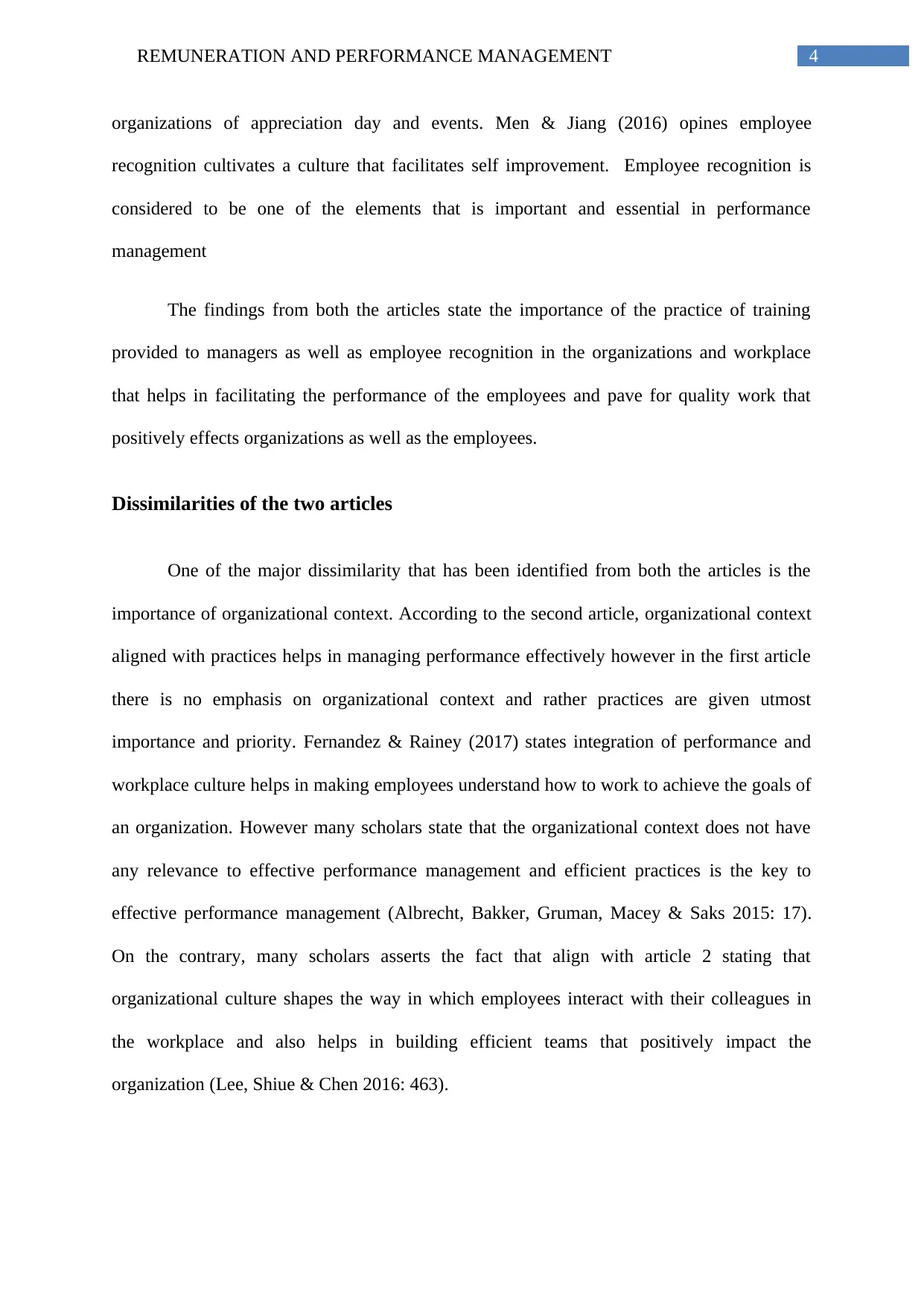
4REMUNERATION AND PERFORMANCE MANAGEMENT
organizations of appreciation day and events. Men & Jiang (2016) opines employee
recognition cultivates a culture that facilitates self improvement. Employee recognition is
considered to be one of the elements that is important and essential in performance
management
The findings from both the articles state the importance of the practice of training
provided to managers as well as employee recognition in the organizations and workplace
that helps in facilitating the performance of the employees and pave for quality work that
positively effects organizations as well as the employees.
Dissimilarities of the two articles
One of the major dissimilarity that has been identified from both the articles is the
importance of organizational context. According to the second article, organizational context
aligned with practices helps in managing performance effectively however in the first article
there is no emphasis on organizational context and rather practices are given utmost
importance and priority. Fernandez & Rainey (2017) states integration of performance and
workplace culture helps in making employees understand how to work to achieve the goals of
an organization. However many scholars state that the organizational context does not have
any relevance to effective performance management and efficient practices is the key to
effective performance management (Albrecht, Bakker, Gruman, Macey & Saks 2015: 17).
On the contrary, many scholars asserts the fact that align with article 2 stating that
organizational culture shapes the way in which employees interact with their colleagues in
the workplace and also helps in building efficient teams that positively impact the
organization (Lee, Shiue & Chen 2016: 463).
organizations of appreciation day and events. Men & Jiang (2016) opines employee
recognition cultivates a culture that facilitates self improvement. Employee recognition is
considered to be one of the elements that is important and essential in performance
management
The findings from both the articles state the importance of the practice of training
provided to managers as well as employee recognition in the organizations and workplace
that helps in facilitating the performance of the employees and pave for quality work that
positively effects organizations as well as the employees.
Dissimilarities of the two articles
One of the major dissimilarity that has been identified from both the articles is the
importance of organizational context. According to the second article, organizational context
aligned with practices helps in managing performance effectively however in the first article
there is no emphasis on organizational context and rather practices are given utmost
importance and priority. Fernandez & Rainey (2017) states integration of performance and
workplace culture helps in making employees understand how to work to achieve the goals of
an organization. However many scholars state that the organizational context does not have
any relevance to effective performance management and efficient practices is the key to
effective performance management (Albrecht, Bakker, Gruman, Macey & Saks 2015: 17).
On the contrary, many scholars asserts the fact that align with article 2 stating that
organizational culture shapes the way in which employees interact with their colleagues in
the workplace and also helps in building efficient teams that positively impact the
organization (Lee, Shiue & Chen 2016: 463).
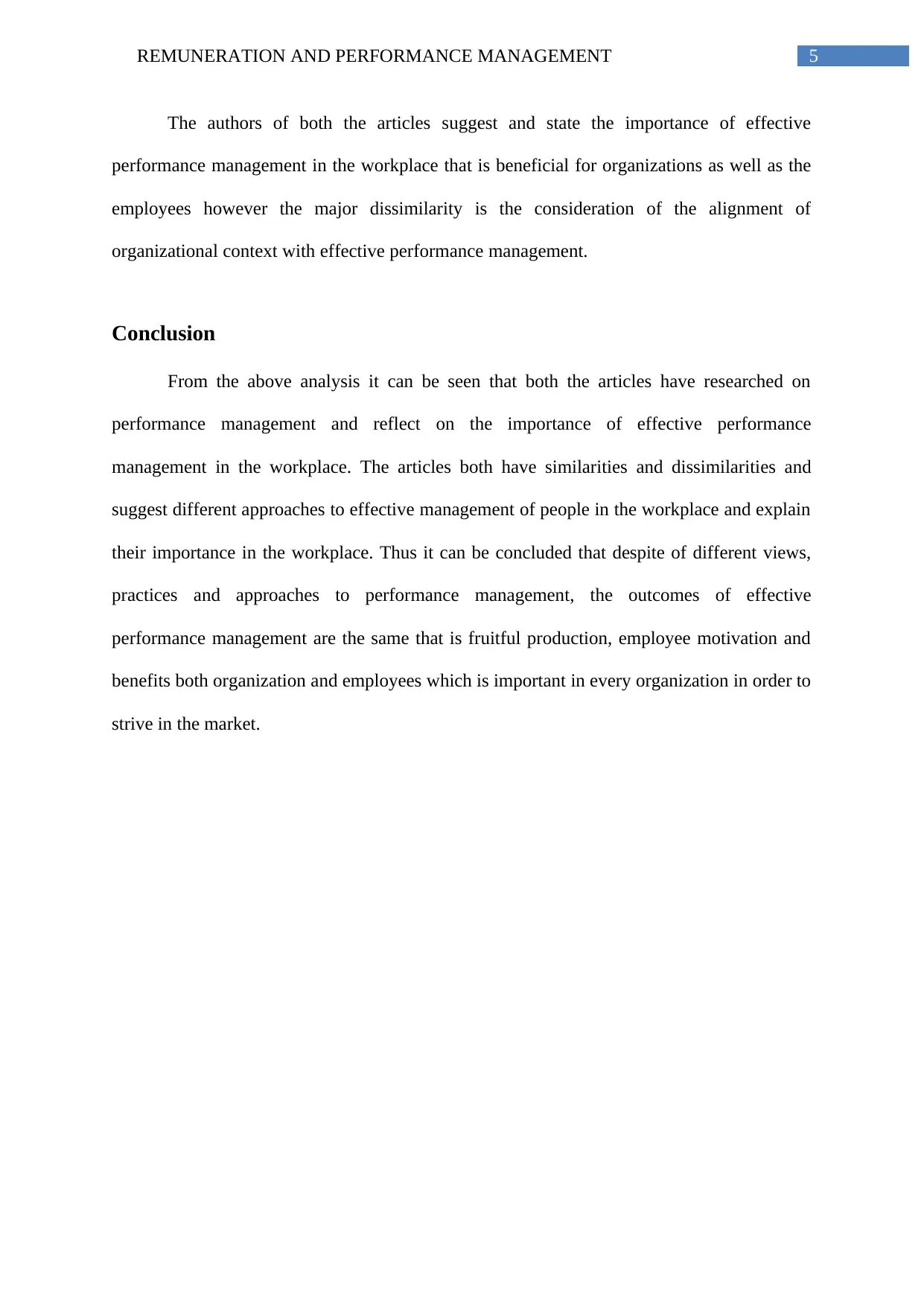
5REMUNERATION AND PERFORMANCE MANAGEMENT
The authors of both the articles suggest and state the importance of effective
performance management in the workplace that is beneficial for organizations as well as the
employees however the major dissimilarity is the consideration of the alignment of
organizational context with effective performance management.
Conclusion
From the above analysis it can be seen that both the articles have researched on
performance management and reflect on the importance of effective performance
management in the workplace. The articles both have similarities and dissimilarities and
suggest different approaches to effective management of people in the workplace and explain
their importance in the workplace. Thus it can be concluded that despite of different views,
practices and approaches to performance management, the outcomes of effective
performance management are the same that is fruitful production, employee motivation and
benefits both organization and employees which is important in every organization in order to
strive in the market.
The authors of both the articles suggest and state the importance of effective
performance management in the workplace that is beneficial for organizations as well as the
employees however the major dissimilarity is the consideration of the alignment of
organizational context with effective performance management.
Conclusion
From the above analysis it can be seen that both the articles have researched on
performance management and reflect on the importance of effective performance
management in the workplace. The articles both have similarities and dissimilarities and
suggest different approaches to effective management of people in the workplace and explain
their importance in the workplace. Thus it can be concluded that despite of different views,
practices and approaches to performance management, the outcomes of effective
performance management are the same that is fruitful production, employee motivation and
benefits both organization and employees which is important in every organization in order to
strive in the market.
⊘ This is a preview!⊘
Do you want full access?
Subscribe today to unlock all pages.

Trusted by 1+ million students worldwide
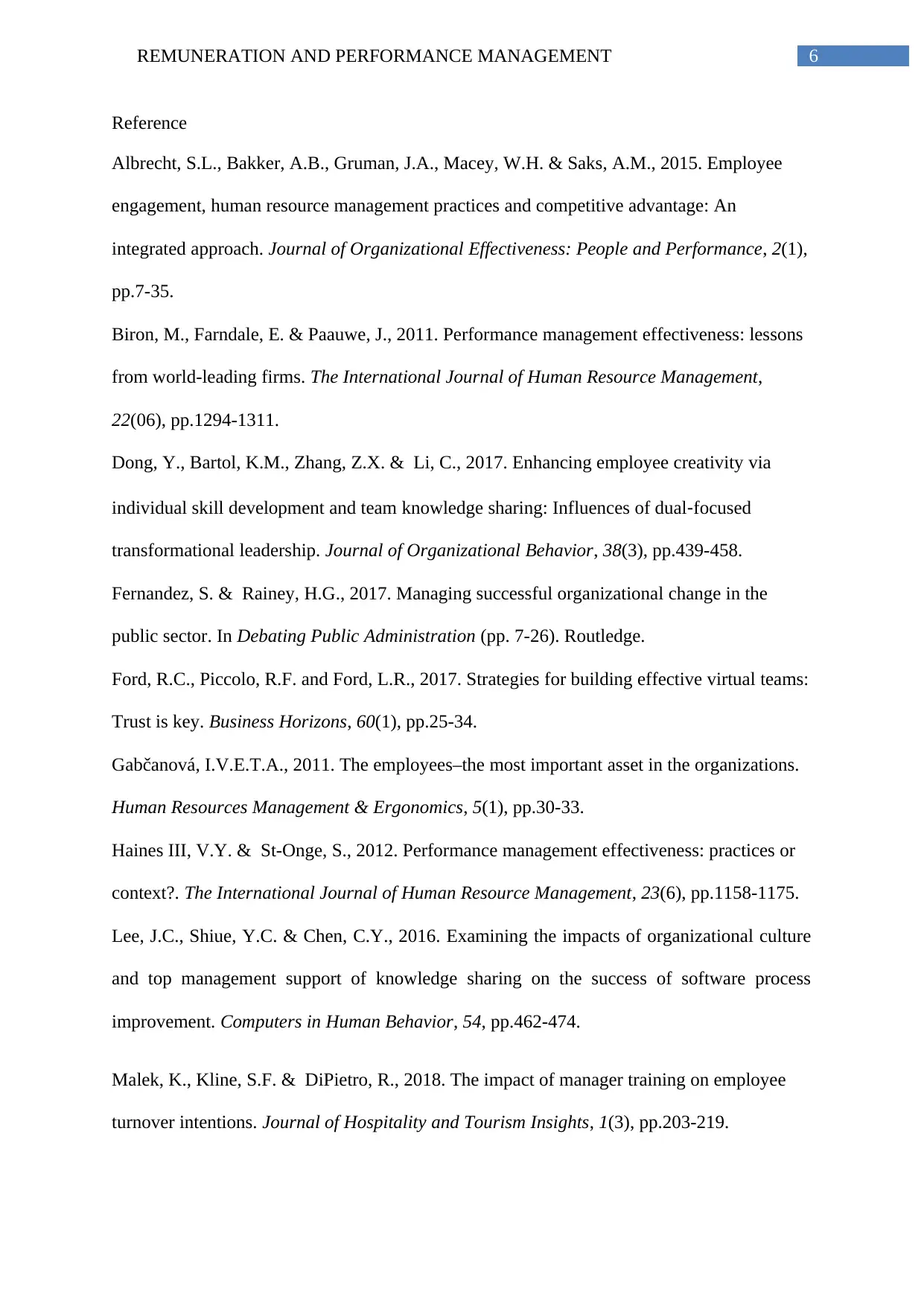
6REMUNERATION AND PERFORMANCE MANAGEMENT
Reference
Albrecht, S.L., Bakker, A.B., Gruman, J.A., Macey, W.H. & Saks, A.M., 2015. Employee
engagement, human resource management practices and competitive advantage: An
integrated approach. Journal of Organizational Effectiveness: People and Performance, 2(1),
pp.7-35.
Biron, M., Farndale, E. & Paauwe, J., 2011. Performance management effectiveness: lessons
from world-leading firms. The International Journal of Human Resource Management,
22(06), pp.1294-1311.
Dong, Y., Bartol, K.M., Zhang, Z.X. & Li, C., 2017. Enhancing employee creativity via
individual skill development and team knowledge sharing: Influences of dual‐focused
transformational leadership. Journal of Organizational Behavior, 38(3), pp.439-458.
Fernandez, S. & Rainey, H.G., 2017. Managing successful organizational change in the
public sector. In Debating Public Administration (pp. 7-26). Routledge.
Ford, R.C., Piccolo, R.F. and Ford, L.R., 2017. Strategies for building effective virtual teams:
Trust is key. Business Horizons, 60(1), pp.25-34.
Gabčanová, I.V.E.T.A., 2011. The employees–the most important asset in the organizations.
Human Resources Management & Ergonomics, 5(1), pp.30-33.
Haines III, V.Y. & St-Onge, S., 2012. Performance management effectiveness: practices or
context?. The International Journal of Human Resource Management, 23(6), pp.1158-1175.
Lee, J.C., Shiue, Y.C. & Chen, C.Y., 2016. Examining the impacts of organizational culture
and top management support of knowledge sharing on the success of software process
improvement. Computers in Human Behavior, 54, pp.462-474.
Malek, K., Kline, S.F. & DiPietro, R., 2018. The impact of manager training on employee
turnover intentions. Journal of Hospitality and Tourism Insights, 1(3), pp.203-219.
Reference
Albrecht, S.L., Bakker, A.B., Gruman, J.A., Macey, W.H. & Saks, A.M., 2015. Employee
engagement, human resource management practices and competitive advantage: An
integrated approach. Journal of Organizational Effectiveness: People and Performance, 2(1),
pp.7-35.
Biron, M., Farndale, E. & Paauwe, J., 2011. Performance management effectiveness: lessons
from world-leading firms. The International Journal of Human Resource Management,
22(06), pp.1294-1311.
Dong, Y., Bartol, K.M., Zhang, Z.X. & Li, C., 2017. Enhancing employee creativity via
individual skill development and team knowledge sharing: Influences of dual‐focused
transformational leadership. Journal of Organizational Behavior, 38(3), pp.439-458.
Fernandez, S. & Rainey, H.G., 2017. Managing successful organizational change in the
public sector. In Debating Public Administration (pp. 7-26). Routledge.
Ford, R.C., Piccolo, R.F. and Ford, L.R., 2017. Strategies for building effective virtual teams:
Trust is key. Business Horizons, 60(1), pp.25-34.
Gabčanová, I.V.E.T.A., 2011. The employees–the most important asset in the organizations.
Human Resources Management & Ergonomics, 5(1), pp.30-33.
Haines III, V.Y. & St-Onge, S., 2012. Performance management effectiveness: practices or
context?. The International Journal of Human Resource Management, 23(6), pp.1158-1175.
Lee, J.C., Shiue, Y.C. & Chen, C.Y., 2016. Examining the impacts of organizational culture
and top management support of knowledge sharing on the success of software process
improvement. Computers in Human Behavior, 54, pp.462-474.
Malek, K., Kline, S.F. & DiPietro, R., 2018. The impact of manager training on employee
turnover intentions. Journal of Hospitality and Tourism Insights, 1(3), pp.203-219.
Paraphrase This Document
Need a fresh take? Get an instant paraphrase of this document with our AI Paraphraser
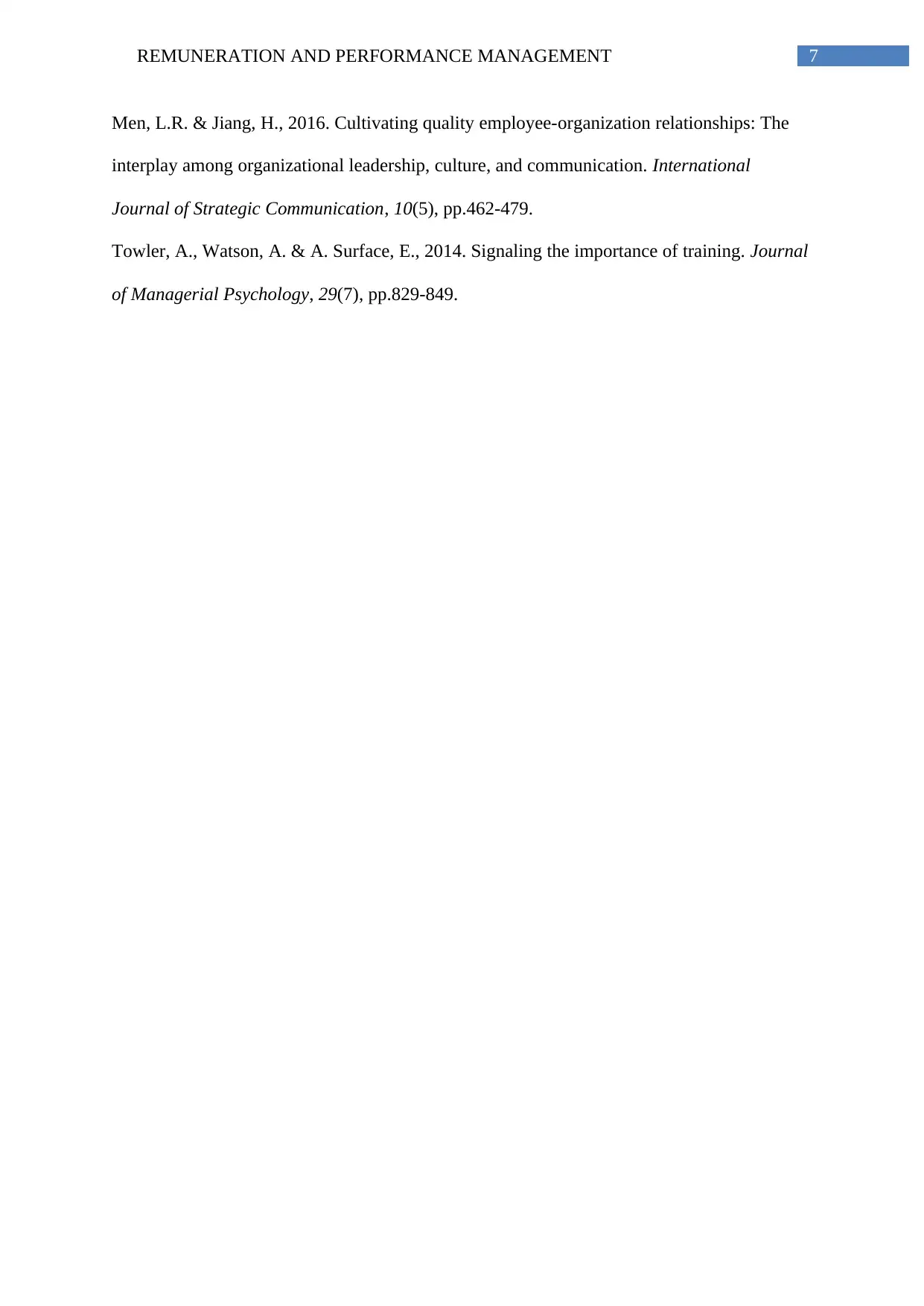
7REMUNERATION AND PERFORMANCE MANAGEMENT
Men, L.R. & Jiang, H., 2016. Cultivating quality employee-organization relationships: The
interplay among organizational leadership, culture, and communication. International
Journal of Strategic Communication, 10(5), pp.462-479.
Towler, A., Watson, A. & A. Surface, E., 2014. Signaling the importance of training. Journal
of Managerial Psychology, 29(7), pp.829-849.
Men, L.R. & Jiang, H., 2016. Cultivating quality employee-organization relationships: The
interplay among organizational leadership, culture, and communication. International
Journal of Strategic Communication, 10(5), pp.462-479.
Towler, A., Watson, A. & A. Surface, E., 2014. Signaling the importance of training. Journal
of Managerial Psychology, 29(7), pp.829-849.
1 out of 8
Related Documents
Your All-in-One AI-Powered Toolkit for Academic Success.
+13062052269
info@desklib.com
Available 24*7 on WhatsApp / Email
![[object Object]](/_next/static/media/star-bottom.7253800d.svg)
Unlock your academic potential
Copyright © 2020–2025 A2Z Services. All Rights Reserved. Developed and managed by ZUCOL.





